China officially introduced the Changhe Z-11WB multipurpose helicopter
The project of the multi-purpose Changhe Z-11WB helicopter is the next development of the Z-11 family. Recall, in the late eighties, the Chinese corporation Changhe Aircraft Industries Corporation (CAIC) began to create a new light helicopter capable of solving a wide range of tasks. To speed up the work, it was decided to use some foreign developments. From the point of view of the main provisions of the design, the Z-11 helicopter became a modified version of the European machine Eurocopter Ecureuil, modified in accordance with the capabilities of the Chinese aviation industry. An interesting feature of the Z-11 project was the development approach. It was the first Chinese helicopter, created only using computer-aided design systems.
The base light-duty multi-purpose helicopter Z-11 first flew at the end of the 1994 of the year. The trials continued for several years and ended only in the autumn of 2000. After that, the car received all the necessary permissions and went into the series. On the basis of the initial design, several specialized modifications were created, differing from each other in basic characteristics and purpose. For example, the People’s Liberation Army of China supplied Z-11W helicopters equipped with light weapons, as well as CW-11W, which were a full-fledged combat vehicle with the ability to use guided missile weapons.
In recent years, CAIC has been developing another modification of an existing multi-purpose helicopter under the designation Z-11WB. This time the aim of the work was to create a machine capable of carrying out reconnaissance and striking at some targets. The main changes in the new project have undergone the composition of the onboard radio-electronic equipment and weapons. Due to the use of new systems with enhanced characteristics, it was planned to improve the capabilities of the helicopter when solving basic tasks. As a result, it is alleged, Z-11WB is able to effectively solve the tasks of patrolling and searching for various objects, as well as destroy the enemy with the help of barrel and rocket weapons.
The main work on the creation of a new helicopter was completed last year. In September 2015, the experienced Z-11WB first took to the air. Since then, the machine has passed at least part of the necessary tests. Also during the past and this year some refinements of the project have been carried out. For several reasons, the helicopter of the new model did not become an exhibit of last year’s exhibition in Zhuhai. Nevertheless, by the next salon, the corporation-developer found it possible to present a new development in the person of a full-fledged prototype. In one of the pavilions of the Airshow China 2016 exhibition there is a prototype helicopter, equipped with a full set of equipment and with various weapons on the external suspension. In addition, some types of weapons are presented next to a helicopter, which demonstrates the breadth of a range of compatible aviation weapons.
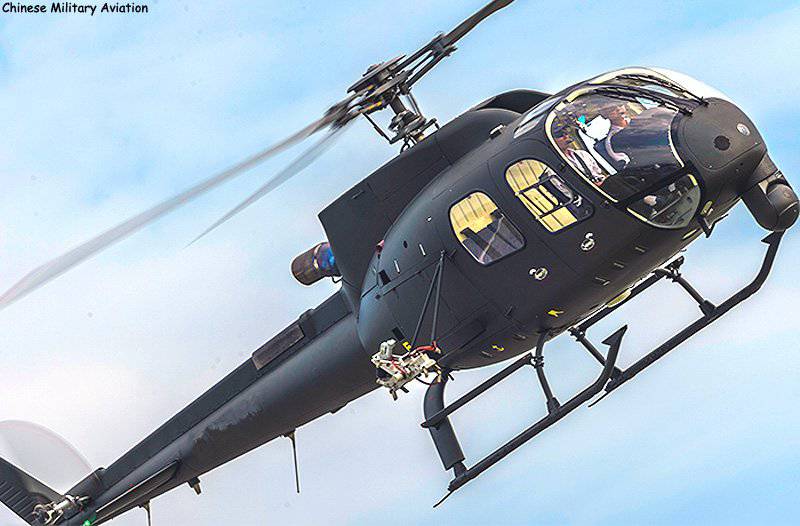
Z-11WB early version in flight. Photo Defence-blog.com
Being the next modification of the existing helicopter, the new Z-11WB retains certain of its features. So, without significant changes remained the scheme of the machine, its overall architecture and the contours of the main units. Installation of new equipment was carried out without significant rework of the existing design. The helicopter retained the classical scheme with main and tail rotor screws, a cockpit for pilots and gunners, a ski landing gear, etc. At the same time, however, Z-11WB has some noticeable external differences from previous machines of its family, primarily related to the installation of new equipment.
The helicopter of the new model again received a fuselage of complex shape, close to the drop-shaped. Most of its volume is given under the cargo cabin. The front part of the cabin is allocated for the placement of pilots and the installation of controls, in the center there is a volume for passengers or payload, and the stern compartment accommodates part of the machine units. There is a tapered tail boom which serves as the basis for the tail rotor and keel. On the roof of the main part of the fuselage there is a cover covering the units of the power plant and transmission. On the sides, behind the cab, there are devices for external suspension of weapons or special equipment.
The nose of the car has retained large glazing, providing the best possible view. For landing in a helicopter is proposed to use two pairs of side doors with glazing. If necessary, the rear doors can be removed, which provides a convenient use of weapons.
Like its predecessors, the new Z-11WB helicopter is equipped with one turboshaft engine of the required power. The previous family of vehicles used engines like WZ-8D with 684 horsepower. A similar power plant is present on the new car. The engine is located in the rear fuselage, above the compartment for other equipment. Directly in front of it is the main gearbox, associated with the rotor and outstanding torque on the steering. Newly used three-lobe main rotor with a diameter of about 11 m.
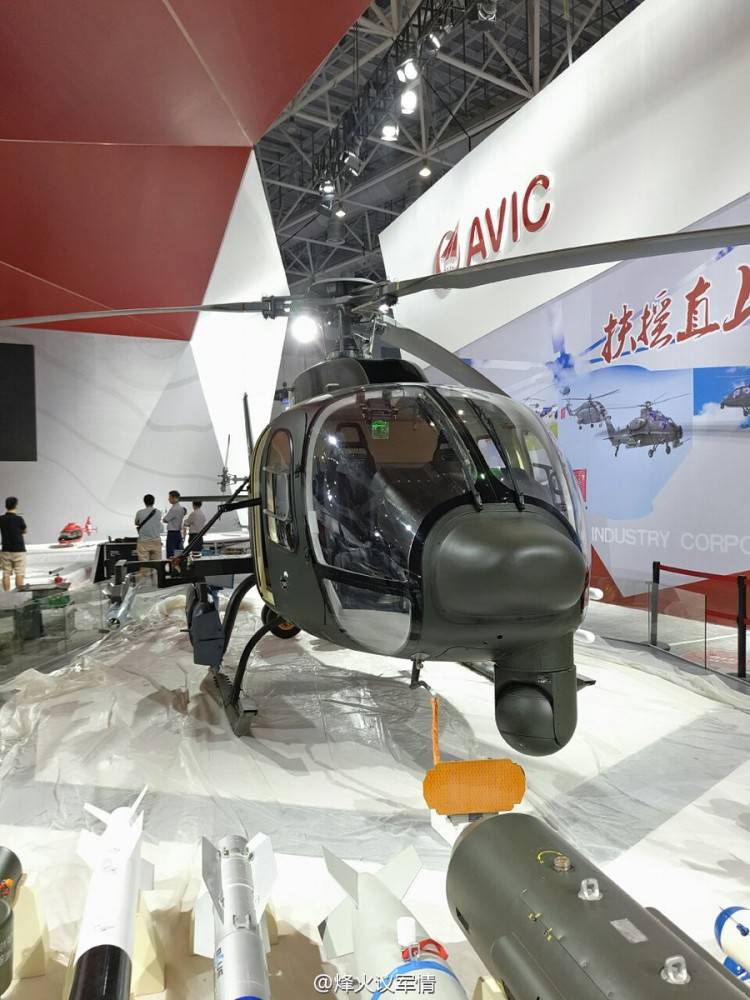
The bow of the machine. One can see the optoelectronic equipment block and the radar model. Photos Twitter.com/xinfengcao
One of the main tasks of a promising helicopter is to monitor the situation and detect various objects, both with the aim of obtaining intelligence data and to carry out an attack. Most of the existing helicopters of the Z-11 family in solving such tasks could only count on the crew’s vision. In the new project, it is proposed to use optoelectronic equipment capable of providing observation of the terrain at any time of the day and in any weather conditions.
Under the nose fuse of the fuselage Z-11WB is placed a block of optical-electronic equipment. Directly to the power set of the machine is attached to the support device, which is a U-shaped support of the main unit. All optical devices are placed inside a spherical fairing with several windows providing observation. Such a design of optical-electronic systems has been repeatedly tested in practice and has proven itself. Due to the possibility of turning the optics in two planes, the crew can monitor the entire lower hemisphere and some parts of the upper one.
It is reported that the new Chinese helicopter received a video camera, thermal imager and laser range finder. All this equipment can be used to search for targets and determine their location, including distance measurement. In addition, in the combat configuration of the helicopter, the optoelectronic equipment unit must also solve the tasks of aiming and targeting. In particular, a laser rangefinder can be used to highlight targets when using guided weapons of the appropriate types.
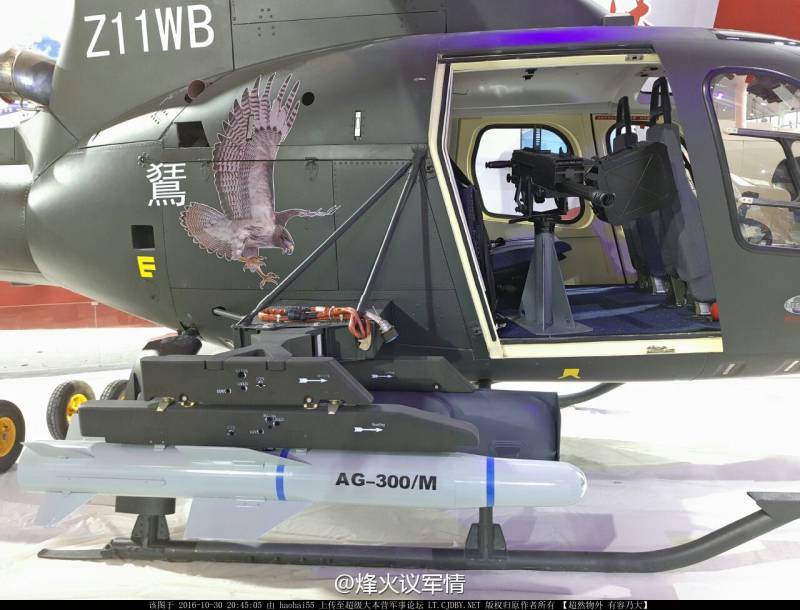
View of the starboard, visible guided missile and weapons in the cockpit. Photo Karelmilitary.livejournal.com
A notable difference of the current Z-11WB sample from the previously seen prototypes is the new nasal fairing. As follows from the announced data, during the modifications, the reconnaissance helicopter received a small-sized radar station. The model of this device is also demonstrated during the exhibition. The characteristics of the radar are not specified, but the very fact of its use can lead to a noticeable increase in the potential of the machine in terms of pilotage and intelligence.
Currently, one of the most effective means of intelligence are unmanned aerial vehicles. The control system of the helicopter Z-11WB was introduced control systems of such equipment. Together with the reconnaissance helicopter, it is proposed to use a SW6 drone. This model of the UAV is adapted for use by light helicopters: the design of the device is designed in such a way that it can be transported to the place of use on an external sling and then launched to the target.
SW6 received a large elongation fuselage, having a section in the form of an ellipse. In the bow of the product, with some shift to the center, there are hinged mounts for deployable wing consoles equipped with ailerons. In front of them there is an additional vertical plane. Two more consoles with vertical stabilizers-tips are hinged in the tail. The tail section of the fuselage is given over to the placement of the propeller group. In the transport position, the high-lying front wing is folded by turning back, while its planes lie on the fuselage. The rear wing of a larger span fits under the fuselage, turning forward. The dimensions of the consoles are such that the vertical stabilizers are placed in front of the nose of the fuselage. On the left side drone there are fasteners for mounting on the carrier pylon. When dropped by the carrier, the apparatus must unfold its wings and begin an independent flight under the control of an operator on board the helicopter.
The composition of the onboard equipment of the SW6 product has not yet been announced, but it is known that the device has remote control systems and optical-electronic means of observation. There is also information about the possible equipment of a UAV warhead, which allows it to be used as a disposable reconnaissance and shock system.
Having on board its own drone, a reconnaissance helicopter can improve the efficiency of observation of the specified area. Unlike a relatively large helicopter, a small UAV is more likely to quietly approach the object being studied and collect all the necessary data. Some questions are still caused by the return of unmanned vehicles from an intelligence departure. Obviously, a Z-11WB helicopter, by definition, cannot take aboard a previously launched aircraft. It is possible that information about the use of the warhead correspond to reality. In this case, the no longer needed “one-time” drone can be aimed at the detected target and used as a guided weapon.
It is assumed that in the future Z-11WB will be used not only for reconnaissance, but also for striking various targets. To do this, the machine can carry various barrel, rocket and bomb weapons. In the passenger cabin of the exhibition sample, on the place of the right passenger seat, a light stand was mounted, on which various receiver systems could be placed. The proposed use of six-barrel 7,62-mm machine gun CS-LM12 with a rotating block of barrels or 40-mm automatic grenade launcher LG-3. This weapon is controlled by the shooter, who is at the left side. For greater ease of use of weapons when installing a machine gun or grenade launcher right side door removed from its place.
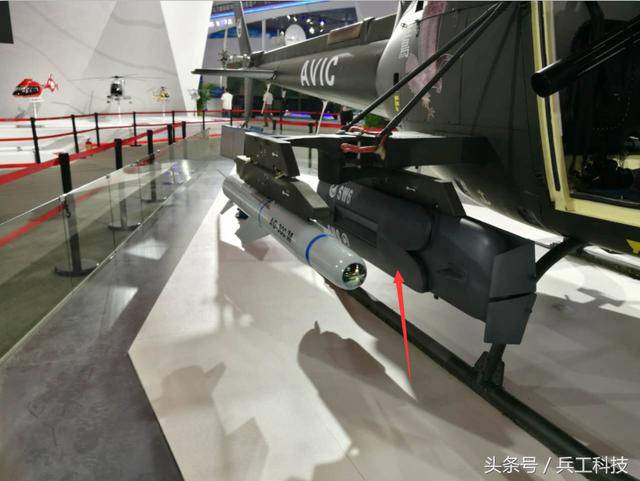
SW6 on a helicopter pylon (marked with an arrow). Photo Bestchinanews.com
On the sides of the fuselage there are external suspension devices with four attachment points for various weapons or systems for other purposes. On the right-hand pylons, the exhibition sample presented in Zhuhai "carries" the AG-300M air-to-ground guided missile and the SW6 drone in the transport position, and the launcher for the four TL-6 guided missiles to the left. At the same time, such a composition of weapons is exclusively demonstrative and far from fully reflects the real capabilities of a multi-function vehicle. Depending on the task, the Z-11WB helicopter can take on various other weapons.
Showing a range of compatible helicopter weapons, Chinese industrialists placed in front of him a dozen different aviation weapons of various classes and types. The helicopter is the carrier of unguided and guided missiles, bombs and other systems. For firing rockets caliber 57 mm used launcher with multiple guides. Guided missiles are proposed to be suspended one by one. Type AG-300M, HJ-8, BA-7 and CM-502KG missiles can be used. To protect against aviation, it is proposed to use TY-90 air-to-air missiles. Also provided for the use of machine gun and cannon hanging containers of existing types. The KG-600 electronic warfare complex and the CLA-01W MIR anti-aircraft missile counter-launch system are compatible with the helicopter.
Despite significant changes in the design and use of new components and assemblies, the Z-11WB helicopter differs slightly in size from the previous family of vehicles. The length of the helicopter does not exceed 11,5 m, the diameter of the rotor is about 11 m. The weight of the empty machine is determined at the level of 1274 kg. Payload - 976 kg. The maximum take-off weight is 2,25 tons. Like its predecessors, the helicopter can reach speeds of no more than 275-280 km / h. Cruising speed is lower and is 240 km / h. Practical ceiling - 5,2 km. Due to the use of the new fuel system with tanks with a total capacity of 535, the helicopter can fly up to 680 km.

UAV on the external suspension (internal pylon). Photos Twitter.com/xinfengcao
The newest helicopter Z-11WB is positioned as a multipurpose machine capable of solving various tasks related to observing or attacking targets. The developed complex of observation systems allows direct reconnaissance of the battlefield or searching for masked enemy targets during covert operations, using both the helicopter’s own optical-electronic equipment and an unmanned aerial vehicle. A wide choice of compatible weapons allows the operator to strike at the found objects or provide direct support to the troops in battlefield. Thus, the appearance of the helicopter allows the customer to choose the most effective methods of its application, using the potential inherent in the project.
Chinese aircraft manufacturers claim that the original appearance of the new helicopter provides high efficiency in various missions and high survivability over the battlefield. With such capabilities, the Z-11WB helicopter may be of interest to the armed forces and law enforcement agencies of various states, including China. However, as far as is known, for the time being there is no question of mass orders for such equipment.
Shortly after the appearance of the first information about the new project, assumptions appeared about the possible ordering of a certain number of Z-11WB machines by the People’s Liberation Army of China. It was predicted about the possible addition of such a fleet of CAIC Z-10 attack helicopters, which are the newest members of their class in the Chinese armed forces. However, these assumptions have not received any confirmations or refutations. Moreover, there is no information about the fact that the Chinese army in general became interested in promising Z-11WB helicopters as a means of updating the fleet of army aircraft.
At the same time, the appearance of an order for the supply of equipment to another Chinese structure is possible. In October, the first reports appeared in foreign media about the possible construction of multi-purpose Z-11WB helicopters on the future order of the People’s Armed Police of China. Such news still remain at the level of rumors, but still can be taken into account when predicting future technology. Rumors suggest that the new technology could not interest the army, but attracted the attention of internal troops. It should be noted that the appearance and capabilities of the helicopter are more in tune with the peculiarities of the work of the internal troops, but not the army.
The new project of Changhe Aircraft Industries Corporation implemented several important ideas and solutions, some of which have already been tested and tested by practice. In this regard, the Z-11WB helicopter, equipped with modern optoelectronic equipment and capable of carrying various weapons, may be of great interest to various foreign customers. Nevertheless, it’s too early to talk about the real commercial potential of the Chinese machine. Messages about negotiations with potential buyers have not been received yet. Perhaps this is due to the fact that the official "premier" of the new reconnaissance-strike machine took place only now, because of which potential buyers have not yet had time to initiate negotiations on possible contracts.
As possible buyers of Changhe Z-11WB helicopters, we can consider various Asian and African countries that have large military budgets. Such states are the main buyers of Chinese weapons and military equipment, which, at an acceptable price, have good characteristics. The stated capabilities of the new helicopter directly indicate its compliance with existing Chinese approaches to creating samples for export deliveries. Thus, in the near future, Z-11WB may indeed be the subject of a contract with one or another foreign country.
Being a further development of fairly old helicopters, the new Chinese machine Z-11WB looks quite interesting and promising. The installation of modern reconnaissance equipment, as well as the original idea regarding the use of a special folding UAV, can attract the attention of specialists, the general public and potential customers. Whether the original project of a multi-purpose helicopter can go further than the tests, go into the series and find buyers, time will tell.
On the materials of the sites:
http://defence-blog.com/
https://shephardmedia.com/
http://sinodefence.com/
http://bestchinanews.com/
http://janes.com/
http://imp-navigator.livejournal.com/
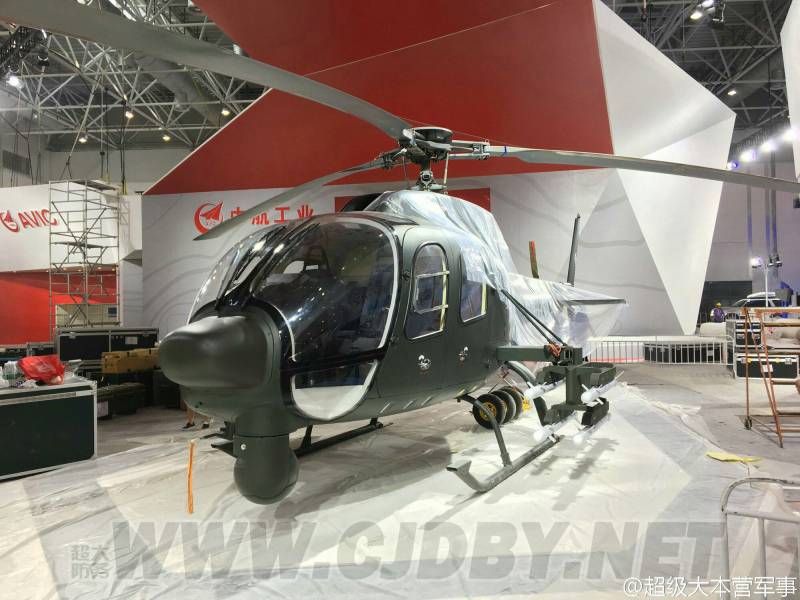
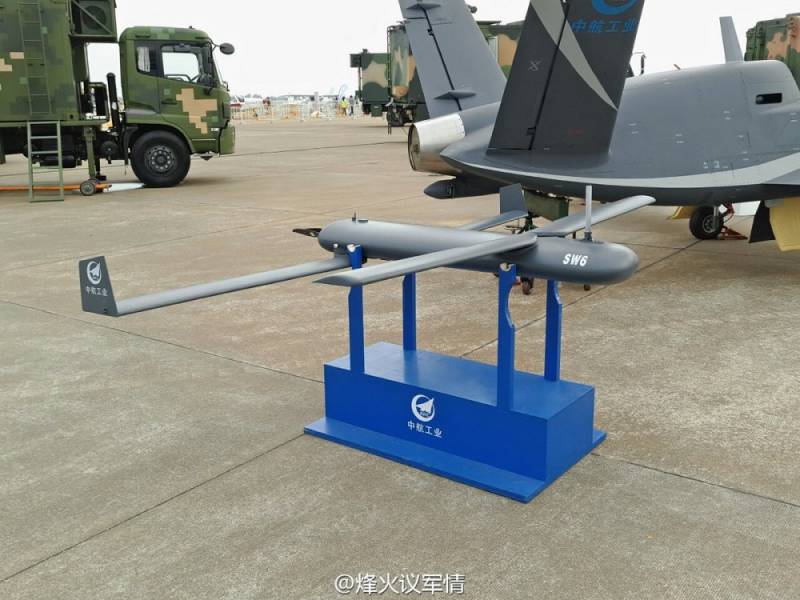
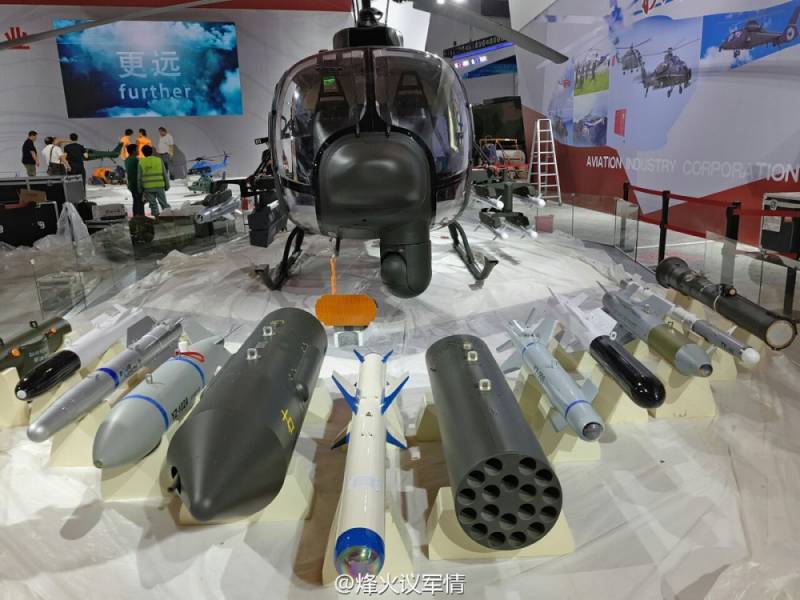
Information